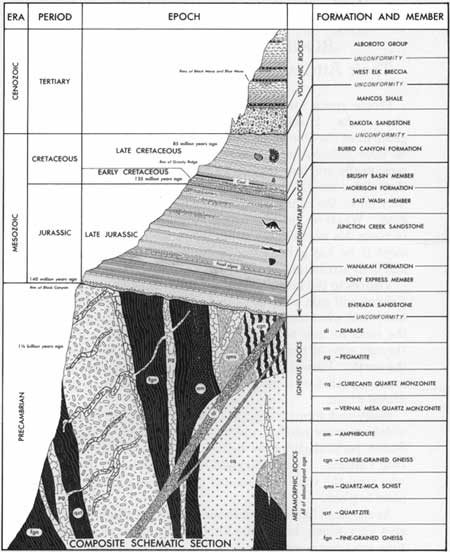
|
Geological Survey Bulletin 1191
Black Canyon of the Gunnison: Today and Yesterday |
ROCK FORMATIONS—
Their Attributes and Geologic Settings
People young and old seem to have an innate curiosity about rocks. Possibly, this is a heritage of man's late emergence from the Stone Age, when his very existence depended on their judicious use! Yet, all too few people know what rocks really are, how they form, how they change, and how they differ among themselves or more significantly, how they affect the course of history and the fortunes of mankind. Whatever the real reason for man's natural interest in rocks, his wonderment grows into a sense of deep enjoyment if he has a basic understanding of rock formations and their attributes.
Visitors to the impressive vantage points along the Black Canyon will gain a fuller appreciation of the canyon if they can relate what they see to the rocks underfoot and relate the rocks in turn to the inexorable forces of nature which through eons of time have shaped and reshaped the face of the earth. Viewed in this light, the canyon acquires new meaning, takes on a unity of design, and becomes an integrated whole.
Many rock formations of the Black Canyon area crop out widely in other parts of the western interior of the United States, particularly in the Rocky Mountains and the Colorado Plateaus. Once recognized, they become old "friends" who greet the traveler again and again as he journeys from place to place.
As shown in figure 8, rock formations in the Black Canyon area vary widely in age and kind. Long spans of geologic time are unrepresented because the area was being eroded or at least nothing was being deposited during much of the time. Rocks that had formed during one geologic period were attacked and removed by erosion during a later period, and parts of the geologic record were destroyed or uninscribed. Much of the geologic history, therefore, is unrecorded or at best is inferred from fragmentary evidence borrowed and pieced together from adjacent areas. Even so, an impressive story can be read from the rocks that remain.

|
| FIGURE 8.—Rock formations of the Black Canyon area. (click on image for an enlargement in a new window) |
The oldest rocks of the Black Canyon belong to the Precambrian System. These rocks are sometimes called the "basement complex," or more simply, the "basement rocks." Radiometric analyses indicate that their age exceeds 1-1/4 billion years. Several types of Precambrian rock are well represented in the canyon walls. All can be assigned, however, to two main classes: metamorphic rocks transformed by heat and pressure from preexisting rocks and igneous rocks intruded into the metamorphic rocks as hot molten masses. Precambrian rocks form virtually all the walls and the floor of the Black Canyon, and they are nowhere in the world better exposed. Locally they form broad upland tracts back from the rims of the canyon, especially on Vernal Mesa, Poverty Mesa, and Coffee Pot Hill, and toward the upper end of the canyon at Fitzpatrick Mesa and the canyon of Blue Creek. In some places younger sedimentary or volcanic rocks cap the rims of the canyon or extend down into the canyon along faults.
| <<< Previous | <<< Contents >>> | Next >>> |
bul/1191/sec4.htm
Last Updated: 28-Mar-2006